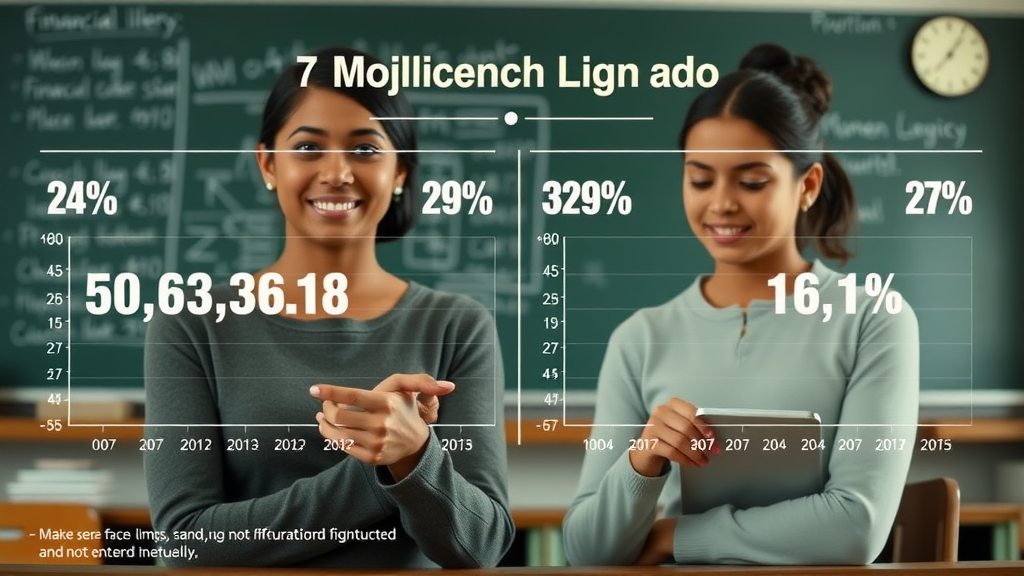Did you know that a staggering number of women and children worldwide lack access to essential financial education, which drastically limits their ability to achieve economic independence? Financial literacy empowerment is more than just knowing numbers - it is a pivotal catalyst for transforming lives and building generational wealth. In this comprehensive article, we explore the expert insights of Ritah Nakiganda, a passionate financial literacy advocate from SHEA KIDS LOUNGE Uganda , whose innovative approach combines practical education and emotional support to unlock financial freedom for women and children. Join us as we delve into the foundational concepts, proven strategies, and inspiring stories that illuminate the pathway to empowerment.
Startling Facts About Financial Literacy Empowerment: Why It Matters Today

Financial literacy empowerment remains an urgent global priority. Studies reveal that nearly 60% of women and children in developing regions lack access to basic money management skills, significantly hampering their potential for economic advancement. This knowledge gap not only limits immediate financial stability but also affects future generations by trapping communities in cycles of poverty.
Today’s interconnected world demands that financial literacy empowerment be at the forefront of educational initiatives. By equipping women and children with budgeting, saving, and investment skills, we empower them to navigate economic uncertainties, build resilience, and achieve sustainable growth. The consequences of neglecting this empowerment can be dire, not just for individuals but for entire economies and societies.
Understanding Financial Literacy Empowerment: Definitions and Core Concepts
The Role of Financial Education in Personal Finance Management
Ritah Nakiganda, a financial literacy advocate, explains,
Financial literacy empowerment is not just about knowledge; it’s about giving women and children the tools to take control of their financial futures.
Financial literacy empowerment encompasses the skills, knowledge, and confidence needed to make informed and effective decisions with all of one's financial resources. It involves understanding key concepts such as budgeting, saving, investing, and debt management. For women and children, those skills often mean gaining independence, improving quality of life, and breaking free from financial dependence or hardship.
In personal finance management, education plays a critical role. Without clear understanding and practical skills, individuals struggle to manage income, control expenses, and plan for emergencies or growth opportunities. Financial education also aids in recognizing scams, avoiding excessive debts, and preparing for future financial challenges. Empowering women and children with these tools creates a foundation of economic self-reliance and confidence.
Ritah Nakiganda’s Journey: Empowering Women and Children Through Financial Literacy

Building Successful Saving Groups and Interactive Training
Ritah Nakiganda's financial literacy empowerment journey is a testament to the transformative power of collective action and education. Over five years, she has successfully built and led saving groups comprising determined women and men, fostering a community where financial knowledge is shared and applied practically. These groups do more than pool money – they cultivate trust, accountability, and shared economic growth.
Her approach includes highly interactive training sessions that go beyond lectures, encouraging participants to engage actively in budgeting and saving exercises. This practical, hands-on learning model helps participants internalize concepts and apply them within their households and small businesses. These saving groups have become incubators for financial independence, offering members both emotional support and the financial discipline necessary for long-term success.
Essential Money Systems Every Small Business Owner Needs for Financial Literacy Empowerment

Managing Inflows, Outflows, and Savings for Business Success
According to Ritah Nakiganda of Centonomy Kenya,
Money systems give you clarity, control, and confidence with your business finances so you’re not just working hard, but working smart.
One of the critical lessons Ritah emphasizes in financial literacy empowerment is the establishment of simple yet effective money systems. Small business owners often struggle not because of lack of effort but due to the absence of structured financial management. Ritah identifies three essential systems: managing inflows (revenue tracking), outflows (expense control), and savings (reserving funds for future needs).
Implementing these money systems brings financial clarity, allowing entrepreneurs to identify cash flow patterns, curb unnecessary expenses, and build reserves for business reinvestment or emergencies. These routines reduce anxiety and financial guesswork, ultimately enhancing decision-making and enabling business growth. For many, adopting these practices is the turning point from mere survival to strategic success.
Raising Capital Beyond Money: Trust, Belief, and Collective Efforts

Equity, Loans, and Community Savings Groups Explained
Raising capital is often perceived as the biggest barrier for small business startups. However, Ritah Nakiganda challenges this notion by highlighting that capital involves more than just money — it’s about trust, belief, and collective effort . Capital can come from equity, loans, or community savings groups, each with unique advantages and considerations.
Equity involves sharing ownership in exchange for resources, which builds partnerships grounded in trust. Loans offer rapid access to funds but require readiness to manage risks and repayment. Community savings groups exemplify collective efforts where members pool resources to uplift each other's ambitions, fostering solidarity and shared success. Ritah’s own experience with Shea Kids Lounge illustrates how belief from a trusted supporter and collective savings catalyzed her business, not just capital infusion.
Ritah Nakiganda’s Personal Story: From Dream to Shea Kids Lounge
Ritah candidly shares that her initial entrepreneurial attempts struggled due to lack of capital and structured money systems. It wasn’t until she garnered trust from her sister, who invested not just money but faith in her vision, that Shea Kids Lounge was born. This story underscores that financial literacy empowerment involves nurturing relationships and community bonds, alongside practical financial knowledge.
Financial Literacy Education: Tools and Strategies for Women and Children

Incorporating Financial Skills into High School and Junior Achievement Programs
| Program Name | Target Audience | Key Features | Measured Outcomes |
|---|---|---|---|
| Centonomy Kenya | Women, Youth | Saving groups, interactive training, emotional support | Increased savings rate, business growth, reduced financial stress |
| Junior Achievement | High School Students | Curriculum integration, simulation games, mentorship | Improved budgeting skills, higher financial confidence |
| SHEA Kids Lounge Workshops | Children, Parents | Hands-on budgeting activities, family involvement | Enhanced parental engagement, early financial literacy skills |
Incorporating financial literacy empowerment programs into education systems is vital for sustaining impact. Ritah advocates embedding financial skills into high school curricula and expanding Junior Achievement programs, which emphasize experiential learning and mentorship. This early intervention equips youth with the tools to manage money wisely before entering adulthood.
Strategically designed workshops like those at SHEA Kids Lounge engage women and children together, creating a supportive learning community. Using practical exercises such as budgeting games and saving challenges, these programs make financial concepts accessible and memorable.
Common Financial Literacy Questions Answered
- What is financial empowerment? Financial empowerment is gaining the knowledge, skills, and confidence to manage money effectively and make informed financial decisions.
- How can financial literacy empower individuals? It enables individuals to plan budgets, save wisely, avoid debt traps, and invest in their futures, thereby gaining independence and control.
- What is the 50 30 20 rule for financial literacy? A budgeting guideline that allocates 50% of income to needs, 30% to wants, and 20% to savings or debt repayment.
- What are the big 3 financial literacy questions? How much money do I earn? How much do I spend? How much do I save?
Key Takeaways on Financial Literacy Empowerment
- Financial literacy empowerment equips individuals with control over their financial futures, fostering independence.
- Money systems are essential for managing business finances effectively, bringing clarity and confidence.
- Capital raising transcends money; trust, belief, and collective efforts play critical roles.
- Early financial education instills lifelong skills that promote generational wealth building.
Conclusion: Building a Future of Financial Freedom Through Education and Empowerment

Financial literacy empowerment stands as a cornerstone in the quest for equitable and sustainable economic development. Through the dedication and innovative approach of leaders like Ritah Nakiganda of SHEA KIDS LOUNGE Uganda , women and children gain more than financial knowledge—they receive the tools to revolutionize their lives and communities. Building robust money systems, fostering trusting relationships for capital, and embedding financial education early are the pillars that support this journey.
As we embrace financial literacy empowerment, we pave the way for greater financial freedom, resilience, and prosperity for all. It is an invitation to work not only harder but smarter, and to empower the next generation to thrive.
People Also Ask: Financial Literacy Empowerment FAQs
-
What is financial empowerment?
Financial empowerment is the ability to make informed and effective financial decisions to improve one’s economic well-being. -
How can financial literacy empower individuals?
By providing the knowledge and skills to handle money wisely, avoid pitfalls, and build wealth for the future. -
What is the 50 30 20 rule for financial literacy?
A budgeting method that divides income into needs (50%), wants (30%), and savings or debt repayment (20%). -
What are the big 3 financial literacy questions?
They focus on understanding income, expenses, and savings to guide financial behavior.
Call to Action: Hidden Heroes - The Changemaker You Should Nominate
Do you know a woman or young individual whose dedication to financial literacy empowerment is making a difference? Nominate your hidden heroes – changemakers transforming their communities through education, saving, and budgeting. Let’s celebrate and amplify their impact. Together, we can build a world where financial freedom is not a dream but a reality for every woman and child.
 Add Row
Add Row  Add
Add 




Write A Comment